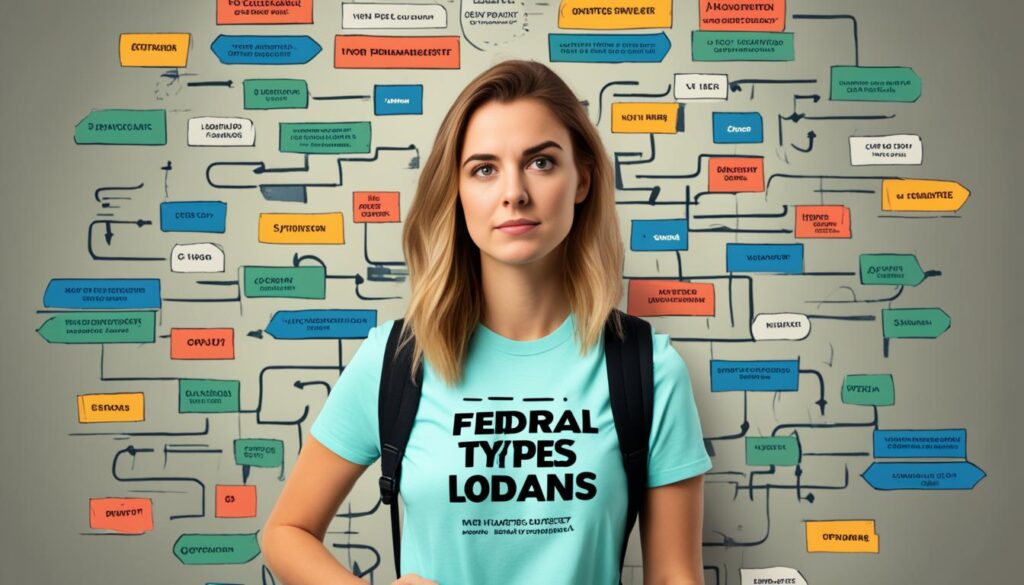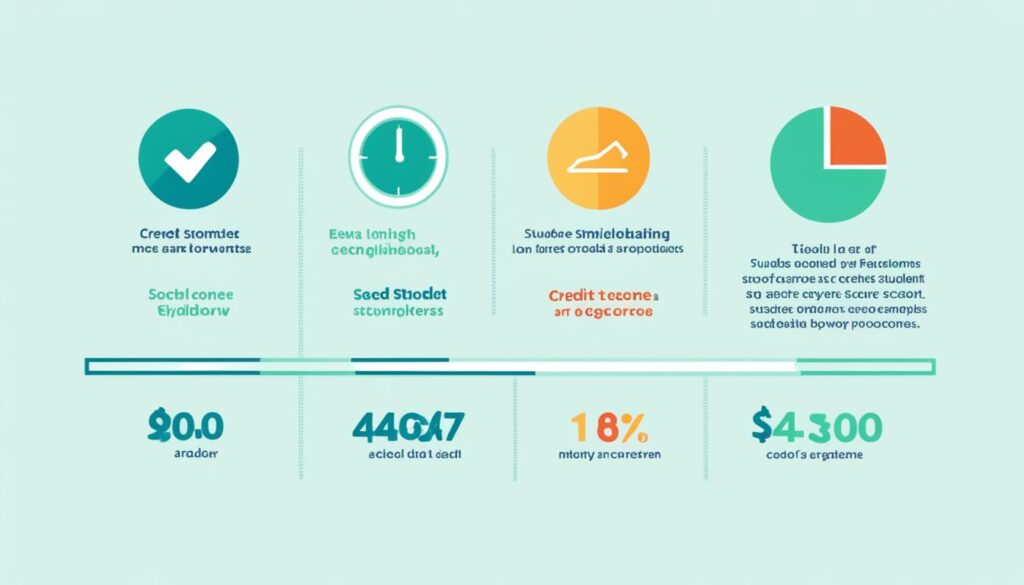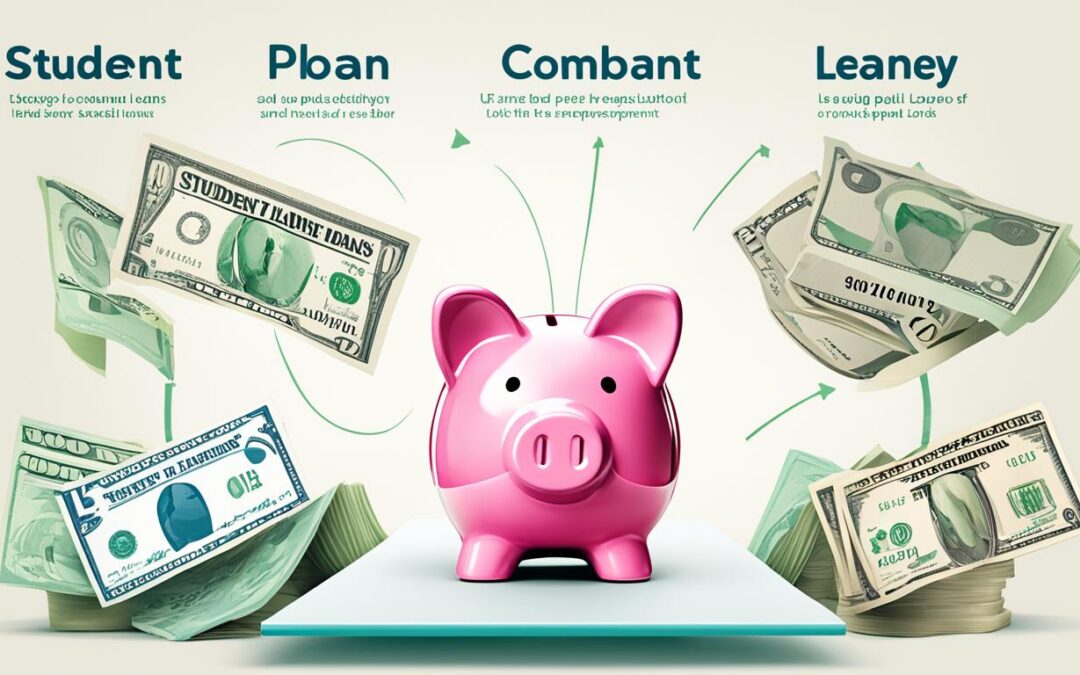Welcome to our comprehensive guide on student loans. If you’re wondering how do student loans work and need an overview of the process, you’ve come to the right place. Whether you’re a high school student planning for college or a graduate looking for repayment options, understanding the ins and outs of student loans is crucial. This guide will walk you through the basics, eligibility requirements, borrowing limits, repayment strategies, and the long-term financial impact of student loans.
Student loans play a vital role in helping students finance their education. They are a form of financial aid that allows you to borrow money to cover tuition, fees, books, and other necessary expenses. However, it’s essential to remember that student loans are not free money and must be repaid over time.
In the following sections, we’ll delve deeper into the various aspects of student loans, starting with the basics. We’ll discuss the different types of student loans, the application process, eligibility requirements, and the purpose of student loans. By the end of this guide, you’ll have a comprehensive understanding of how student loans work and how they can impact your financial future.
Understanding the Basics of Student Loans
Student loans are an essential financial tool for many individuals pursuing higher education. To make informed decisions about student loans, it’s crucial to have a clear understanding of their basics.
Defining Student Loans and Their Purpose
Student loans are borrowed funds that help students cover the costs associated with their education. These costs can include tuition, books, fees, and living expenses. The purpose of student loans is to provide financial assistance to students who may not have the immediate means to pay for their education outright.
The important thing to remember about student loans is that they are not free money; they need to be repaid, typically with interest. Borrowers should carefully consider their future ability to repay the loans and make informed decisions about borrowing amounts.
Differences Between Federal and Private Student Loans
There are two primary types of student loans: federal loans and private loans. Understanding the differences between the two is essential.
Federal student loans are issued by the government and offer certain advantages such as fixed interest rates, a variety of repayment plans, and loan forgiveness or discharge options. These loans also provide borrower protections like income-based repayment and deferment or forbearance options.
On the other hand, private student loans are provided by banks, credit unions, or other lenders. They often have variable interest rates, and their terms and conditions may vary from lender to lender. Private loans may be suitable for individuals who have exhausted their options for federal aid or who need additional funding to cover educational expenses.
Overview of the Loan Application Process
The loan application process for student loans can vary depending on whether you are applying for federal loans or private loans.
For federal loans, the first step is to complete the Free Application for Federal Student Aid (FAFSA). The FAFSA determines your eligibility for federal aid programs, including grants, work-study opportunities, and loans. Once your FAFSA is processed, you will receive a Student Aid Report (SAR) that indicates the financial aid you are eligible for.
To apply for private student loans, you will need to research and compare lenders to find the best terms and interest rates. Each lender will have its own application process, which may include providing proof of enrollment, income, and creditworthiness. It’s essential to carefully review the terms and conditions of private loans before accepting an offer.
| Factors | Federal Student Loans | Private Student Loans |
|---|---|---|
| Interest Rates | Fixed, set by the government | Variable, set by the lender |
| Borrower Protections | Income-driven repayment plans, loan forgiveness options | Varies by lender, generally fewer borrower protections |
| Eligibility Requirements | Based on financial need and other factors | Dependent on creditworthiness and other criteria set by the lender |
Understanding the basics of student loans, including their definitions, differences, and application processes, is crucial for making informed decisions about financing your education.
The Two Main Types of Student Loans
When it comes to financing your education, there are two main types of student loans: federal and private. Understanding the differences between these types of loans is crucial in making an informed decision about your financial future.
Federal Student Loans: An Attractive Option for Borrowers
Federal student loans are loans provided by the government to help students and their families cover the cost of education. These loans often come with several advantages:
- Fixed Interest Rates: Federal student loans typically offer fixed interest rates, meaning the rate remains the same throughout the life of the loan, providing stability and predictability in repayment.
- Flexible Repayment Plans: Federal loans provide various repayment plans, including income-driven options that adjust monthly payments based on your income and family size. This flexibility can make loan repayment more manageable.
- Borrower Protections: Federal loans come with borrower protections, such as deferment and forbearance options, which allow you to temporarily pause or reduce your loan payments in certain circumstances, such as financial hardship or returning to school.
Federal student loans are often considered a more attractive option for borrowers due to their favorable terms and benefits.
Private Student Loans: When Federal Aid Isn’t Enough
While federal student loans are a great option for many, they may not cover all of your educational expenses. In cases where federal aid falls short, private student loans can fill the funding gap.
Private student loans are offered by banks, credit unions, and other financial institutions. These loans often have different terms and conditions compared to federal loans:
- Variable Interest Rates: Private student loans typically offer variable interest rates, which can fluctuate over time. It’s important to understand the terms of these loans and how the interest rates may impact your overall repayment.
- Less Flexible Repayment Options: Unlike federal loans, private student loans may have fewer repayment options and borrower protections. It’s essential to carefully review and compare different private loan options to ensure they align with your financial goals.
- Credit and Income Requirements: Private lenders consider factors such as credit history, income, and employment when determining eligibility for their loans. This means that you may need a cosigner or meet certain criteria to qualify for a private student loan.
Private student loans provide a valuable resource for students who need additional funding beyond what is offered through federal aid. However, it’s crucial to carefully evaluate the terms and conditions of private loans before committing to them.
How Do Student Loans Work: Navigating Federal Loans
In order to successfully navigate federal student loans, it is crucial to have a solid understanding of the various repayment options available. This section will provide you with detailed information on federal loan repayment options, including income-driven repayment plans and loan forgiveness programs.
One important aspect of navigating federal loans is familiarizing yourself with the terms and conditions associated with each repayment plan. This will help you make informed decisions regarding your loan repayment strategy and ensure that you choose the right plan that aligns with your financial circumstances.
Income-driven repayment plans are designed to make your monthly loan payments more manageable based on your income and family size. These plans adjust your monthly payments according to your discretionary income, allowing you to repay your loans without causing excessive financial strain.
Additionally, federal student loans offer loan forgiveness programs for borrowers who meet certain criteria. These programs can potentially relieve you of a portion or even the entire remaining balance of your federal loans if you meet requirements such as working in public service or teaching in a low-income area.
By understanding the various federal loan repayment options available to you, you can navigate the complex world of student loans more effectively and make choices that are in your best interest.

Interest Rates and How They Affect Your Debt
The Role of Interest Rates in Loan Repayment
When it comes to student loans, interest rates play a significant role in determining the overall cost of borrowing. The interest rate is the percentage of the loan amount that lenders charge borrowers for the privilege of borrowing the money. It is important to understand how interest rates impact your loan repayment to make informed decisions about your finances.
The interest on your student loans begins accruing as soon as the funds are disbursed. This means that the longer it takes you to repay your debt, the more interest will accumulate over time. The higher the interest rate, the more you will end up paying in interest over the life of the loan.
Interest rates have a direct impact on your monthly loan payments. Higher interest rates result in larger monthly payments, while lower interest rates lead to smaller payments. Additionally, the total amount you repay over the life of the loan can be significantly affected by the interest rate.
Fixed vs. Variable Interest Rates: What You Need to Know
When taking out student loans, you will typically have the option to choose between fixed and variable interest rates.
Fixed interest rates remain the same throughout the life of the loan. This means that your monthly payments will remain consistent, making it easier to budget and plan for repayment. Fixed interest rates provide stability and certainty, as the rate is locked in and unaffected by changes in the market.
Variable interest rates, on the other hand, can fluctuate over time. These rates are often based on the current market conditions and can be influenced by factors such as the economy, inflation, and changes in the Federal Reserve’s monetary policy. While variable interest rates may start lower than fixed rates, there is a risk that they could increase, potentially resulting in higher monthly payments.
When deciding between fixed and variable interest rates, it is important to consider your financial situation, risk tolerance, and long-term repayment plans. If stability and predictability are important to you, a fixed interest rate may be the better option. However, if you are confident in your ability to handle potential rate increases and want to take advantage of potentially lower initial rates, a variable interest rate may be more suitable.
| Fixed Interest Rates | Variable Interest Rates |
|---|---|
| Remain the same throughout the life of the loan | Can fluctuate over time based on market conditions |
| Provide stability and predictability | Potentially lower initial rates, but with the risk of rate increases |
| Easier to budget and plan for repayment | May result in higher monthly payments if rates increase |
Tackling Repayment: Strategies to Manage Student Debt
Managing student debt can be a daunting task, but with the right strategies, you can develop a repayment plan that works for you. In this section, we will explore various student loan repayment strategies and how they can help you effectively manage your debt.
Understanding Your Repayment Plan Options
When it comes to repaying your student loans, there are several options available to you. It’s essential to understand these options and choose the one that aligns with your financial goals and circumstances.
Here are some common repayment plan options:
- Standard Repayment Plan: This plan allows you to make fixed monthly payments over a specific period, usually 10 years.
- Income-Driven Repayment Plans: These plans adjust your monthly payments based on your income and family size, making them more affordable for borrowers facing financial challenges.
- Graduated Repayment Plan: This plan starts with lower monthly payments that gradually increase over time, allowing borrowers to adjust their payments as their income potential grows.
- Extended Repayment Plan: This plan extends the repayment period beyond the standard 10 years, resulting in lower monthly payments.
Each repayment plan has its advantages and eligibility criteria. Make sure to research and consult with your loan servicer to determine the best repayment option for your specific needs.
The Impact of Additional Payments on Loan Term and Interest
Making additional payments towards your student loans can have a significant impact on reducing your loan term and saving on interest payments. By making extra payments, you can:
- Pay off your loan faster: By applying extra funds towards your principal balance, you can shorten the overall repayment period.
- Save on interest: Paying off your loan sooner means you’ll accumulate less interest over time, resulting in potential savings.
It’s important to note that when making additional payments, you should specify that the extra amount should be applied to the principal balance rather than future payments. This will ensure that your additional payments have the desired effect of reducing your loan term and saving on interest.
Remember, every little bit counts. Even small additional payments can make a significant impact over time. Consider allocating extra funds towards your student debt whenever possible.
Now that we’ve explored repayment plan options and the impact of additional payments, you can develop a strategic approach to manage your student debt effectively. By understanding your repayment options and taking advantage of opportunities to make extra payments, you can take control of your financial future and work towards a debt-free life.
Eligibility and Borrowing Limits: Know What You Can Borrow
This section provides valuable insights into understanding the eligibility requirements and borrowing limits for student loans. By familiarizing yourself with these factors, you can make informed decisions about your financing options and plan your educational journey accordingly.
How Financial Need Influences Loan Amounts
When determining loan amounts, your financial need plays a crucial role. Financial need is calculated by subtracting your expected family contribution (EFC) from the total cost of attendance (COA). The COA includes expenses such as tuition, fees, books, and living costs. The resulting figure represents the maximum amount you can borrow based on demonstrated financial need.
It’s essential to note that financial need is evaluated differently for federal and private loans. Federal loans take into account factors such as income, family size, and assets, while private lenders may have their own criteria.
Federal Loan Limits and Private Loan Differences
Federal student loans have specific borrowing limits set by the government. These limits vary depending on your status as a dependent or independent student and your academic year. For example, undergraduate dependent students typically have lower borrowing limits compared to independent students or graduate students.
Here’s an overview of the borrowing limits for federal student loans:
| Loan Type | Dependent Students | Independent Students | Graduate/Professional Students |
|---|---|---|---|
| Direct Subsidized Loans | $5,500 – $7,500 per year | $5,500 – $12,500 per year | N/A |
| Direct Unsubsidized Loans | $2,000 additional per year | $7,000 additional per year | $20,500 per year |
| PLUS Loans (for parents and graduates/professionals) | Cost of attendance minus other aid received | Cost of attendance minus other aid received | Cost of attendance minus other aid received |
On the other hand, private student loan limits are determined by the lender and are typically based on factors such as creditworthiness and the cost of attendance. Private loans may allow you to borrow higher amounts than federal loans, but it’s crucial to carefully consider the terms, interest rates, and repayment options offered by private lenders.

Understanding student loan eligibility and borrowing limits is essential for proper financial planning. By comprehending the role of financial need in determining loan amounts and being aware of the specific loan limits for federal and private loans, you can make informed decisions about your borrowing options.
Allocation of Student Loan Funds: What Can They Cover?
In order to make the most of your student loan funds, it’s important to understand what expenses they can cover. Student loan funds are designed to help you finance your education and related costs, ensuring that you have the necessary resources to succeed academically. By responsibly allocating your student loan funds, you can effectively manage your expenses and make the most of your borrowing.
Covered Expenses: From Tuition to Living Costs
Student loan funds can be used to cover a variety of expenses related to your education. Here are some of the main items that student loan funds can typically cover:
- Tuition and fees: Student loan funds can be applied towards the cost of tuition and fees charged by your educational institution.
- Books and supplies: You can use your student loan funds to purchase the necessary textbooks, study materials, and supplies required for your courses.
- Living costs: Student loans can help cover your living expenses, including rent, utilities, and groceries.
- Transportation: Funds can be used for transportation costs, such as commuting to and from campus, or travel expenses for internships, conferences, or study abroad programs.
- Technology: Student loan funds can be used to purchase computer equipment, software, and other technology necessary for your studies.
- Personal expenses: Loans can also be allocated for personal expenses, such as healthcare costs, clothing, and other day-to-day needs.
It’s important to note that while student loan funds can cover a wide range of expenses, it’s essential to use them responsibly. Borrowing more than you need can lead to unnecessary debt and financial burden in the future.
Responsible Borrowing: Only Borrow What You Need
When it comes to student loans, responsible borrowing is key. It’s important to carefully assess your financial needs and only borrow the amount necessary to cover your educational expenses. Here are a few tips for practicing responsible borrowing:
- Create a budget: Before taking out a student loan, create a budget that outlines your income, expenses, and anticipated borrowing needs. This will help you determine exactly how much you need to borrow.
- Minimize unnecessary expenses: Look for ways to minimize your expenses and save money. Consider purchasing used textbooks, cooking meals at home instead of eating out, and exploring cost-saving measures for rent and utilities.
- Explore other funding options: In addition to student loans, explore other sources of funding, such as scholarships, grants, and part-time employment. These can help reduce your overall borrowing needs.
- Understand repayment terms: Familiarize yourself with the terms and conditions of your student loan, including interest rates, repayment options, and any fees or penalties that may apply. This will help you make informed decisions regarding your borrowing.
- Keep track of your borrowing: Regularly monitor your student loan balance and keep track of how much you’ve borrowed. This will help you stay aware of your financial obligations and make informed decisions about future borrowing.
By practicing responsible borrowing and only borrowing what you truly need, you can manage your student loan funds effectively and minimize your long-term debt burden. Remember, student loans are an investment in your future, and it’s important to use them wisely.
The True Cost of Student Loans
In order to fully understand the impact of student loans on your finances, it is essential to consider the true cost of borrowing. Calculating the long-term financial impact of student loans can help you make informed decisions and better plan for the future. Additionally, it’s important to be aware of the various loan fees and additional costs that may be associated with student loans.
Calculating the Long-Term Financial Impact of Student Loans
When considering student loans, it’s crucial to take into account the long-term financial impact they can have. This involves calculating the total cost of the loan, which includes both the principal amount borrowed and the interest that accrues over time.
One way to estimate the total cost of student loans is to use an online loan repayment calculator. These calculators take into account factors such as interest rates, loan terms, and repayment plans to provide an estimate of the total amount you will repay over the life of the loan.
It’s important to note that the longer it takes to repay your student loans, the more interest you will end up paying. Therefore, it’s generally beneficial to pay off your loans as quickly as possible to minimize the long-term financial impact.
Loan Fees and Additional Costs to Consider
In addition to the principal amount and interest, there are other costs associated with student loans that should be taken into consideration.
Loan origination fees, for example, are charged by some lenders to cover the administrative costs of processing the loan. These fees are typically a percentage of the loan amount and are deducted upfront, reducing the actual disbursement amount.
Late payment fees are another potential cost to be aware of. If you miss or make a late payment on your student loans, you may be subject to fees or penalties, increasing the overall cost of the loan.
It’s also important to consider the opportunity cost of student loans. By taking on debt to fund your education, you may be limiting your ability to pursue other financial goals, such as saving for retirement or buying a home.
Conclusion
As you reach the end of this comprehensive guide to student loans, it’s important to reflect on the full picture of this financial commitment. By understanding how student loans work, you can make informed decisions and take the necessary steps towards achieving long-term financial success after graduation.
First and foremost, it’s crucial to grasp the implications of student loans on your financial future. As you embark on your repayment journey, carefully consider the amount you borrow, interest rates, and repayment options. By being proactive and well-informed, you can minimize the impact on your overall financial well-being.
Looking ahead, it’s never too early to start preparing for financial success post-graduation. Take advantage of resources that will help you budget effectively, prioritize expenses, and save responsibly. Building an emergency fund can provide a safety net for unexpected expenses, offering peace of mind as you navigate the world beyond college.
Furthermore, don’t underestimate the importance of exploring career opportunities. Take advantage of internships, networking events, and job fairs to gain industry experience and increase your chances of securing a well-paying job. By starting your career on the right foot, you’ll be better positioned to tackle your student loan debt and achieve your long-term financial goals.


